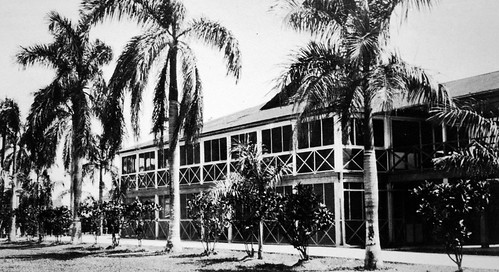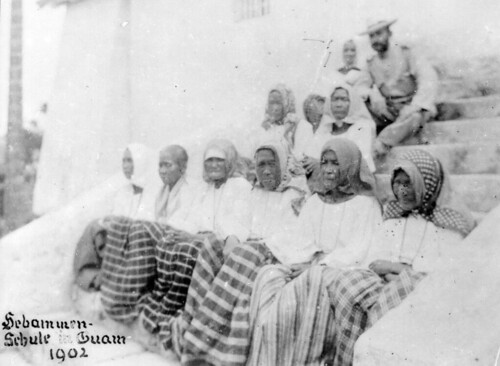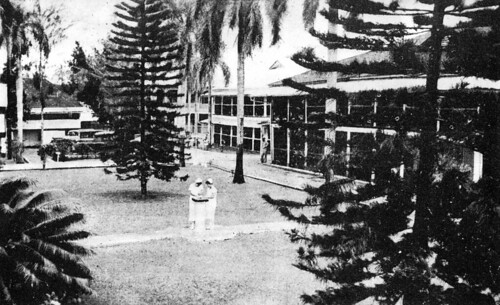US Naval Hospital 1899-1941
Established in Hagåtña in 1899
The first US Naval Hospital in Guam was established in Hagåtña in August 1899 by Surgeon Philip Leach. Since many Chamorros at the time consulted with suruhånu/suruhånas (traditional healers) for medical concerns, the hospital was the only source of modern western medicine on the island. Soon the US Naval Hospital began treating the entire population of Guam. Between August 1899 and July 1900 the hospital’s staff had treated 1,141 patients of a population of 9,630 civilians.
Because of a shortage of personnel the medical officers began training Chamorro women to be health workers. The first class was held in midwifery in 1901 with the newly-trained pattera or mid-wives delivering 325 babies that year. This first class also marked the beginning of a long teaching tradition between the US Navy and the Chamorro people.
The Maria Schroeder Hospital in Hagåtña opened in 1902 for the treatment of dependents and local civilians and the US Naval Hospital began treating the active duty and indigent.
Earthquake destroys original structure
Then, on 22 September 1903, an earthquake hit Guam and the original Naval hospital was destroyed. A portion of the Maria Schroeder Hospital was rented to provide space for the treatment of the enlisted men. In 1905 a small building near the Maria Schroeder Hospital, known as the Susana Hospital, was rented and used to treat women and children until it was destroyed by an earthquake in 1909. Naval medical personnel staffed both the Maria Schroeder and Susana Hospitals. The Federal Government appropriated money to rebuild the Susana Hospital with the rather unusual condition that it be known as the US Naval Hospital, Guam.
In August 1910 the two hospitals became the US Naval Hospital, Guam. The hospital was unique at that time because it was the only US Naval Hospital with a women’s and children’s ward.
The following year, the first three Navy nurses arrived, and a formal nursing school was started. By 1912 the US Naval Hospital staffed two Navy and seven Chamorro nurses. Six years later there were eight Navy and twelve Chamorro nurses at the hospital, and eleven dressing stations in the villages; six of these were run by Hospital Corpsmen and the other five by Chamorro school teachers.
From its founding the staff of the US Naval Hospital provided the services of a typical community hospital to its patients, taught health care workers, and did important research in tropical medicine.
By 1940 nine doctors (including Dr. Ramon M. Sablan, a Chamorro trained in the United States), one dentist, two pharmacists, five Navy nurses, 46 pharmacist’s mates, seven hospital apprentices, and 14 Chamorro nurses were assigned to the hospital. After captive US citizens were sent from Guam to Japanese Prisoner of War camps in January 1942 during World War II, Dr. Sablan and the Chamorro nurses provided almost all of the health care for islanders during the war years.
By Alice Hadley
Naval Hospital Librarian, Guam
For further reading
Carano, Paul, and Pedro C. Sanchez. A Complete History of Guam. Rutland: Charles E. Tuttle, Co., 1964.
DeLisle, Christine Taitano. Placental Politics: CHamoru Women, White Womanhood, and Indignity under US Colonialism in Guam, The University of North Carolina Press, Chapel Hill, 2022.
Hadley, Alice E. “A Brief History of the U.S. Naval Hospital, Guam, 1899-2001.” Guam Virtual Medical Library, 1996. Last modified 21 January 2005.
Hattori, Anne Perez. Colonial Dis-ease: U.S. Navy Health Policies and the Chamorros of Guam, 1898-1941. Pacific Islands Monograph Series 19. Honolulu: University of Hawai`i Press, 2004.
Thompson, Laura M. Guam and Its People. With a Village Journal by Jesus C. Barcinas. 3rd ed. New Jersey: Princeton University Press, 1947.
Time. “Guam’s Doctor.” 6 November 1944.






